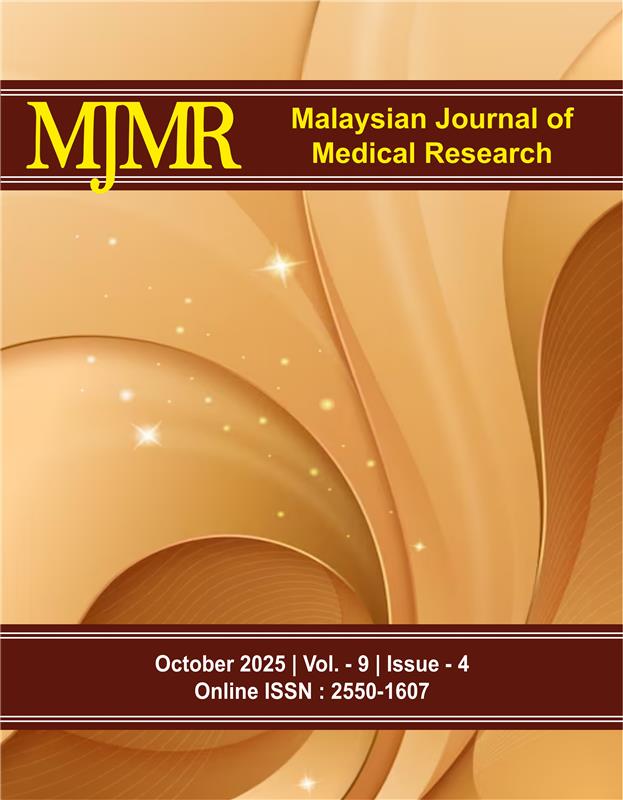Emergency Care Management of Blunt Thoracic Chest Wall Trauma in Traumatic Cardiac Arrest
DOI:
https://doi.org/10.31674/mjmr.2025.v09i04.006Abstract
This case report describes the emergency management of a 35-year-old female motorcyclist who sustained critical injuries following a high-impact collision with a bus in Malaysia. The patient was brought to the Emergency Department of Hospital Selayang on April 24, 2025, where immediate resuscitation was initiated. Despite aggressive trauma life support measures, the patient succumbed after 30 minutes of continuous resuscitation efforts. The case highlights the clinical presentation and diagnostic evaluation of blunt thoracic chest wall trauma leading to traumatic cardiac arrest. On arrival, the patient was pulseless and required immediate cardiopulmonary resuscitation, advanced airway management, and insertion of bilateral chest tubes for hemothorax. Circulatory support included large-bore intravenous access, administration of crystalloids, and emergency blood transfusion. Point-of-care ultrasound revealed minimal pericardial effusion, prompting pericardiocentesis, although only minimal fluid was drained. Despite timely interventions and adherence to trauma resuscitation protocols, the patient did not achieve return of spontaneous circulation. The outcome emphasises the devastating consequences of blunt thoracic trauma, particularly massive hemothorax, and the challenges faced in managing traumatic cardiac arrest in emergency settings. This report underscores the importance of a systematic and structured approach in trauma care, including rapid assessment, identification of reversible causes, and early activation of multidisciplinary teams. It also highlights the need for continuous training, infrastructure development, and adherence to trauma protocols to optimise outcomes. Although survival in such cases remains rare, effective emergency systems and timely interventions remain essential for improving the chances of recovery.
Keywords:
Blunt Thoracic Trauma, Emergency Resuscitation, Massive Hemothorax, Trauma Life Support, Traumatic Cardiac ArrestDownloads
References
American College of Surgeons Committee on Trauma. (2018). Advanced trauma life support (ATLS®) student course manual (10th ed.). American College of Surgeons. https://store.facs.org/atls-student-course-manual-10th-edition
Hospital Selayang. (n.d.). Kecemasan & Trauma [Emergency & Trauma]. Jabatan Kesihatan Negeri Selangor. https://jknselangor.moh.gov.my/hselayang/index.php/perkhidmatan/medical-services/emergency-department
Hunt, P. A., Greaves, I., & Owens, W. A. (2006). Emergency thoracotomy in thoracic trauma—A review. Injury, 37(1), 1–19. https://doi.org/10.1016/j.injury.2005.04.002
Tan Chor Lip, H., Huei Tan, J., Mohamad, Y., Chairil Ariffin, A., Imran, R., & Tuan Mat, T. N. A. (2019). Clinical characteristics of 1653 injured motorcyclists and factors that predict mortality from motorcycle crashes in Malaysia. Chinese journal of traumatology, 22(02), 69-74. https://mednexus.org/doi/full/10.1016/j.cjtee.2018.11.001
Lockey, D. J., Lyon, R. M., & Davies, G. E. (2013). Development of a simple algorithm to guide the effective management of traumatic cardiac arrest. Resuscitation, 84(6), 738–742. https://doi.org/10.1016/j.resuscitation.2012.11.012
Van Rutte, P. W. J., Smulders, J. F., De Zoete, J. P., & Nienhuijs, S. W. (2014). Outcome of sleeve gastrectomy as a primary bariatric procedure. Journal of British Surgery, 101(6), 661-668. https://doi.org/10.1002/bjs.9447
Rhee, P. M., Foy, H., Kaufmann, C., Areola, C., Boyle, E. M., Maier, R. V., & Jurkovich, G. J. (1998). Penetrating cardiac injuries: A population-based study. Journal of Trauma: Injury, Infection, and Critical Care, 45(2), 366–370. https://doi.org/10.1097/00005373-199808000-00030
Gummadi, S., Murali, S., Chreiman, K., Forsythe, L., Yelon, J. A., Cannon, J. W., & Seamon, M. J. (2025). Emergency Department Thoracotomy: Time to Stop–A Trauma Video Review. Journal of Surgical Research, 310, 203-208. https://doi.org/10.1016/j.jss.2025.03.016
Published
How to Cite
Issue
Section
License
Copyright (c) 2025 Malaysian Journal of Medical Research (MJMR)

This work is licensed under a Creative Commons Attribution-NonCommercial-NoDerivatives 4.0 International License.























